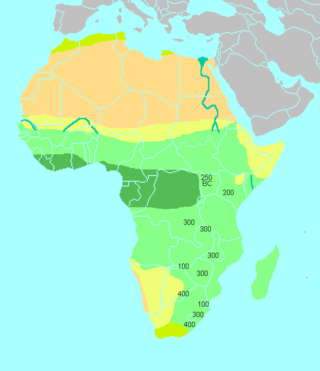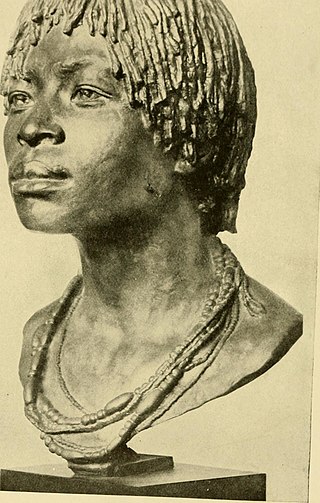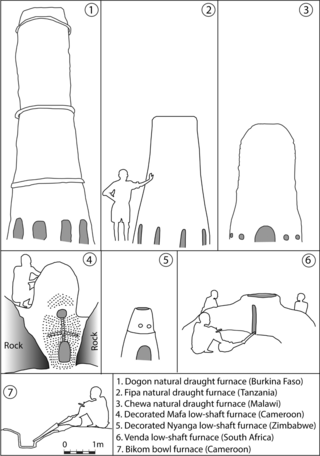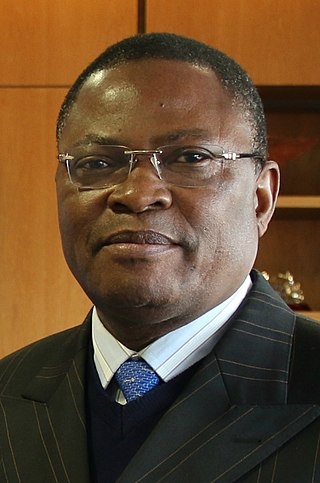Related Research Articles

The Jamestown settlement in the Colony of Virginia was the first permanent English settlement in the Americas. It was located on the northeast bank of the James River, about 2.5 mi (4 km) southwest of the center of modern Williamsburg. It was established by the Virginia Company of London as "James Fort" on May 4, 1607 O.S., and was considered permanent after a brief abandonment in 1610. It followed several failed attempts, including the Lost Colony of Roanoke, established in 1585 on Roanoke Island, later part of North Carolina. Jamestown served as the colonial capital from 1616 until 1699. Despite the dispatch of more settlers and supplies, more than 80 percent of the colonists died in 1609–10, mostly from starvation and disease. In mid-1610, the survivors abandoned Jamestown, though they returned after meeting a resupply convoy in the James River.

The Bantu expansion is a hypothesis about the history of the major series of migrations of the original Proto-Bantu-speaking group, which spread from an original nucleus around Central Africa. In the process, the Proto-Bantu-speaking settlers displaced, eliminated or absorbed pre-existing hunter-gatherer and pastoralist groups that they encountered.


The Kongo people are a Bantu ethnic group primarily defined as the speakers of Kikongo. Subgroups include the Beembe, Bwende, Vili, Sundi, Yombe, Dondo, Lari, and others.

Africa has the longest record of human habitation in the world. The first hominins emerged 6-7 million years ago, and among the earliest anatomically modern human skulls found so far were discovered at Omo Kibish, Jebel Irhoud, and Florisbad.

The ruins of Gedi are a historical and archaeological site near the Indian Ocean coast of eastern Kenya. The site is adjacent to the town of Gedi in the Kilifi District and within the Arabuko-Sokoke Forest.
Madingo-Kayes is a town lying on the edge of the coastal rainforest at the mouth of the Kouilou River on the Atlantic Ocean of the Republic of the Congo. It is the capitale of Madingo-Kayes District.

The Kingdom of Loango was a pre-colonial African state, during approximately the 16th to 19th centuries in what is now the western part of the Republic of the Congo, Southern Gabon and Cabinda. Situated to the north of the more powerful Kingdom of Kongo, at its height in the 17th century Loango influence extended from Cape St Catherine in the north to almost the mouth of the Congo River.
Ishango is a Congolese lakeshore site located in the north-eastern region of the Democratic Republic of Congo in Africa, previously known as Zaire. This present day village is known as a "fishermen settlement" as it lies on the shores of the Semliki River, flowing out of Lake Edward, serving as one of the sources of the Nile River. This site is known best for its rich biodiversity and archaeological significance, indicating previous human occupation.

Parting Ways was an African-American settlement of freedmen adjacent to present-day Route 80 in Plymouth, Massachusetts, near the Plymouth/Kingston town line. Other names for Parting Ways include the Parting Ways Archeological District and the Parting Ways New Guinea Settlement. It was founded on 94 acres (380,000 m2) by four former enslaved people who fought in the American Revolutionary War: Cato Howe, Prince Goodwin, Plato Turner, and Quamony Quash and their families. They were granted their freedom by the Massachusetts courts due to their service in the war. The land was granted in 1792 as part of an agreement with the town of Plymouth, that whosoever could clear the land could claim ownership of it. Part of this land was added to the National Register of Historic Places on April 19, 1979.

Madingo-Kayes is a district in the Kouilou Region of far south-western Republic of the Congo. The capital lies at Madingo-Kayes.
Batadombalena is an archaeological site with evidence of habitation from 8,000 years BCE, Balangoda Man, located 85 km (52.8 mi) from Colombo in Sri Lanka, a two-hour drive from Colombo.

Copper metallurgy in Africa encompasses the study of copper production across the continent and an understanding of how it influenced aspects of African archaeology.

Fidèle Dimou is a Congolese politician who has served in the government of Congo-Brazzaville as Minister of Transport since 2017. Previously he was Prefect of Kouilou Department from 2006 to 2017.

Central Africa is generally considered to encompass ten countries which amounts to more than six million square kilometers or roughly the size of the United States west of the Mississippi River. Despite its large size, very little archaeological research has been done in the region.
François Luc Macosso was a Congolese politician.
Kayes is a city in Mali.

The history of Central Africa has been divided into its prehistory, its ancient history, the major polities flourishing, the colonial period, and the post-colonial period, in which the current nations were formed. Central Africa is the central region of Africa, bordered by North Africa, West Africa, East Africa, Southern Africa, the Atlantic Ocean, and the Sahara Desert. Colonial boundaries are reflected in the modern boundaries between contemporary Central African states, cutting across ethnic and cultural lines, often dividing single ethnic groups between two or more states.
Bosutswe is an archaeological site at the edge of the Kalahari Desert in Botswana on top of Bosutswe Hill. The site can be dated back to around 700 AD. The location of Bosutswe makes it easy for archaeologists to study as the record of the site is continuous. It is believed that the area was occupied consistently for around 1000 years. It was known for its advanced metalworking which first appeared around 1300 AD, which is known as the Lose Period. The Lose Period is named after the elite class that can be found in the area.
Mduuni Ruins is protected historic site located inside Micheweni District of Pemba North Region in Tanzania. The settlement was established around 1100 CE.
References
- Denbow, James. "Congo to Kalahari: data and hypotheses about the political economy of the western stream of the Early Iron Age." African Archaeological Review 1990, Volume 8, Issue 1, pp 139-175